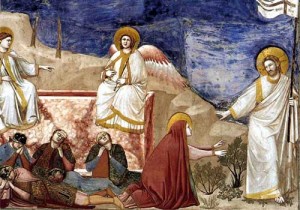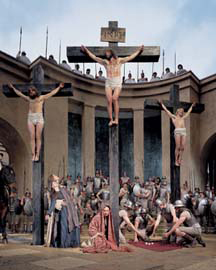I have found myself in recent years insisting that people believe their ears and not their eyes. Now our flesh demands to see by its own unregenerate power, only then will the flesh say it believes. But the truth is our flesh does not often believe even when it sees. We usually figure, “they have some way of doing that” or perhaps we’ll say, “This is a trick, an illusion.” And illusionist can do some pretty amazing stuff! (See the video below).
But the Scriptures are clear to say that Faith comes by hearing and hearing by the Word of God (Rom 10:17) . It also says, Faith is the substance of things hoped for and the evidence of things unseen (Heb 11:1). Even Thomas who is said to believe because he sees is really confessing something he cannot see, that Jesus is Lord and God (Jn 20:29).
For example, when it comes to the sacraments we have to believe our ears for our eyes cannot see the reality that faith declares to be so. St. Thomas Aquinas in the beautiful hymn Adoro Te Devote says:
-
- Visus, tactus, gustus in te fallitur, (Sight and taste and touch in thee fall short)
- Sed auditu solo tuto creditur; (But only the hearing is safely believed)
- Credo quidquid dixit Dei Filius, (I believe whatever the Son of God has said)
- Nil hoc verbo veritatis verius. (Nothing is truer than this word of truth)
And thus I must often remind people when it comes to sacraments:
- Though your eyes may still see bread and wine, believe your ears: “This is my Body, This is my Blood…..” (Matt 26:26 inter al). The Bread I will give is my flesh for the Life of the world….(Jn 6:51).”
- Though your eyes may still see a newly married bride and groom as two separate distinct individuals, believe your ears: “They are no longer two, they are one. What God has joined together let no one divide.” (Matt 19:6)
- Though your eyes may see a newly baptized baby as just the same, believe your ears: “This is my beloved son in whom I am well pleased….(Lk 3:21) If anyone is in Christ he is a new creation (2 Cor 5:17)…..We who were baptized into Christ Jesus were baptized into his death so that just as Christ was raised from the dead by the glory of God the Father we too might live in newness of life (Rom 6:4)
- A person who emerges from a confessional may appear just the same, but believe your ears: I absolve you from your sins..…Whose sins you forgive, they are forgiven them (Jn 20:23).
What are you going to believe….your eyes or your ears?
- [For] we look not to what is seen but to what is unseen; for what is seen is transitory, but what is unseen is eternal….for we walk by faith, not by sight (2 Cor 4:18, 5:7).
- And to the Pharisees who claimed they could see (but still refused to believe) the Lord said, “If you were blind, you would not be guilty, But you remain guilty because you claim you can see. (John 9:41)
- And to those who do believe the Lord says through Peter: You have not seen him, yet you love him; and still without seeing him you believe in him and so are already filled with a joy so glorious that it cannot be described (1 Peter 1:8)
What are you going to believe, your eyes or your ears?
Your flesh demands to see. But I promise you, even if you do see, your flesh will explain it away. Consider this video. Illusionists can do some pretty amazing things. But notice how quickly your flesh is willing to explain it away. And this case it should for these are illusions. But what if you saw a real miracle? What do you suppose your flesh would do? What do you suppose?
Faith comes by hearing.






